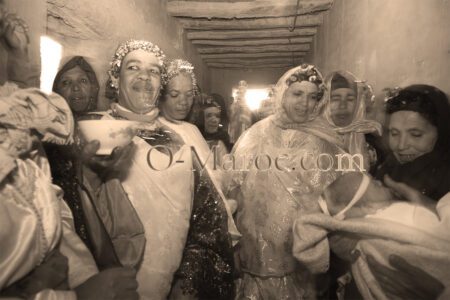Tiguemmi – ⵜⵉⴳⵎⵎⵉ, is the house, and by extension the heritage, but also those who live in the house. When we greet each other, we ask how things are going, and how the house is going, and therefore all those who live there… and that can be a lot.
The Berber house is usually made of mud, with walls built in wooden moulds, blending in perfectly with its surroundings. But in some villages, where stone is more prevalent than earth, or where the winters are particularly cold, the houses may be made of stone.

Even in the heights of the Atlas mountains, the roofs are flat and terraced, except perhaps in Azrou and Ifrane… or in other places I haven’t yet visited. But these are towns that owe a lot to colonisation, so it’s hard to talk about a “Berber house”.

Here’s a fun fact: many applications translate Casablanca’s name as ⵜⵉⴳⵎⵉ ⵜⵓⵎⵍⵉⵍⵜ (Tigmi toumlilt), which literally means “House covered in lime”, and therefore “White House”. The Amazigh name for the town has always been Anfa: ⴰⵏⴼⴰ.
Tigmi or Tiguemmi?
I’ve corrected the text, following a comment from a Berber and Arabic-speaking friend: in Morocco it’s pronounced tiguemmi and not “tigmi”.
I checked, the “official” transcription (the Ircam one) is ⵜⵉⴳⵎⵎⵉ instead of ⵜⵉⴳⵎⵉ.
ⵜⵉⴳⵎⵉ is therefore a “generic Berber”, probably derived from the first dictionaries (and therefore from Kabyle), which has spread everywhere.
Tigmi is used in Morocco for the names of riads and guest houses… and for the fanciful transcription of the name Casablanca, further proof that this ⵜⵉⴳⵎⵉ ⵜⵓⵎⵍⵉⵍⵜ is not the “Moroccan Berber” name of the capital.
 A typo or syntax error? You can select the text and hit Ctrl+Enter to send us a message. Thank you! If this post interested you, maybe you can also leave a comment. We'd love to exchange with you !
A typo or syntax error? You can select the text and hit Ctrl+Enter to send us a message. Thank you! If this post interested you, maybe you can also leave a comment. We'd love to exchange with you !




